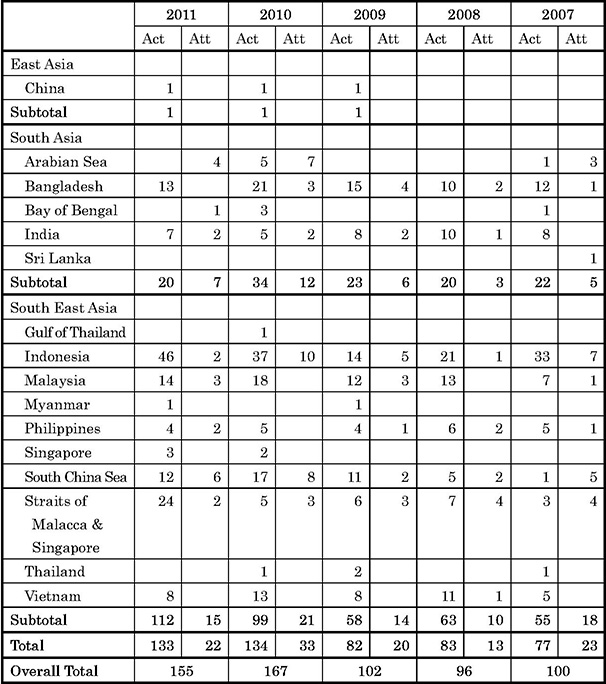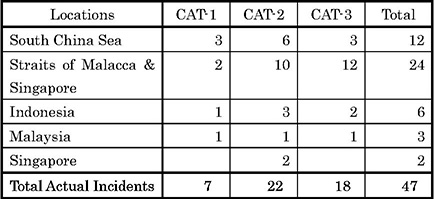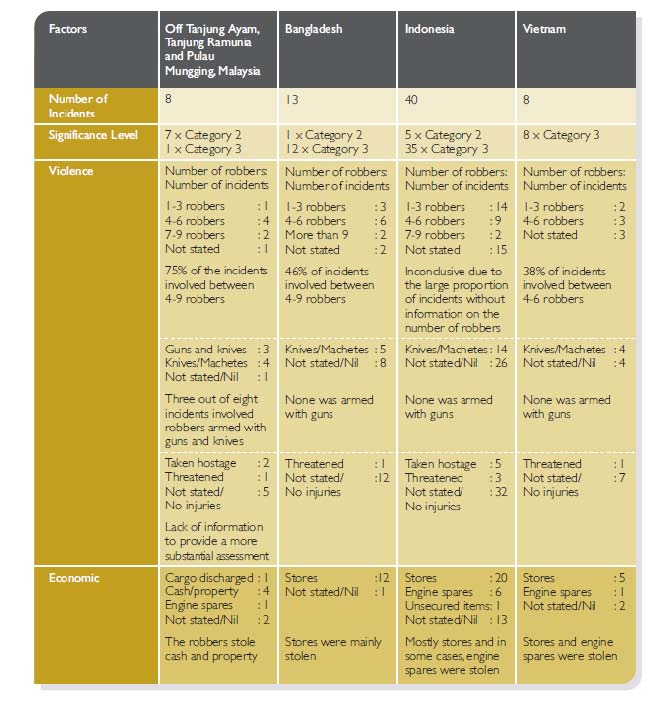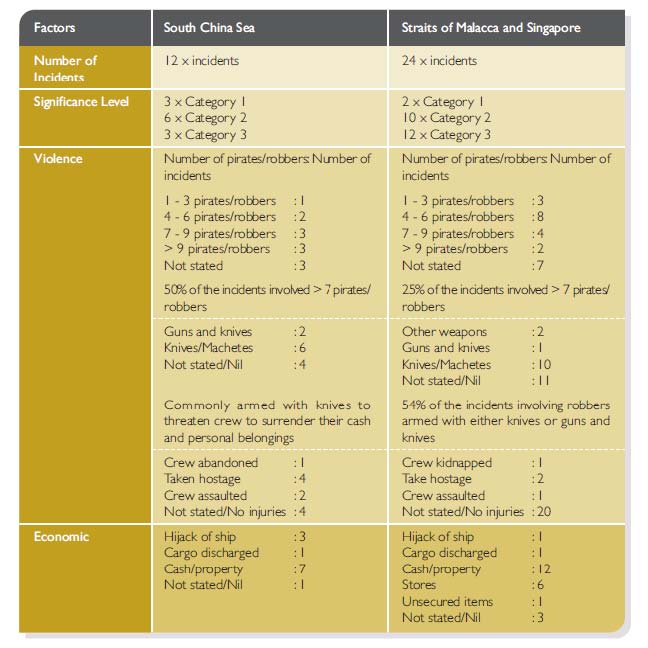Piracy and Armed Robbery against Ships in Asia in the year 2011 From ReCAAP Annual Report
Contents
In January 2012, the Information Sharing Center (ISC) of the Regional Cooperation Agreement on Combating Piracy and Armed Robbery against Ships in Asia (ReCAAP) which was established, based on ReCAAP, issued the annual report on the incidents of piracy and armed robberies against ships noted in Asia in the year 2011 (hereinafter, the Report).. (ReCAAP is an abbreviation of the Regional Cooperation Agreement against Piracy.)
While the similar report of the International Maritime Bureau (IMB) covers world-wide areas, the ReCAAP’s report covers the regional areas stretching from the Arabian Sea to northeast Asia via southern rim of the Eurasian continent. In addition, while the IMB makes use of reports from non-government vessels and shipping owners as its main sources of information, the ReCAAP’s information sources are connecting the member-nations with Focal Point in Hong Kong and Singapore-based Information Sharing Center (ISC), which is an Information Sharing Web, composed of mutual connections with Focal Point. The focal points of the respective nations are located in the coast guard, maritime police, ministry of agency in charge of marine transportation and maritime affairs, and/or navy. (In case of Japan, the focal point is located in Japan Coast Guard.) Also, the focal points of the respective nations are coordinating with the law enforcement agencies, navy, port authorities, custom authorities, and shipping circles among others of the nations concerned. Moreover, the ReCAAP is using data from the International Maritime Organization (IMO), IMB, and others.
At present, the 17-member ReCAAP consists of the 14 regional nations of India, Sri Lanka, Bangladesh, Myanmar, Thailand, Singapore, Cambodia, Laos, Vietnam, Brunei, Philippines, China, Republic of Korea and Japan plus the three non-regional nations of Norway (joining in August 2009), Denmark (joining in July 2010), and the Netherlands (joining in November 2010). Although Malaysia and Indonesia are non-members, they are conducting exchanges of information with the ISC.
The following are the patterns and trends of the incidents of piracy and armed robbery against the ships noted from the ReCAAP report of the Asian region in 2011. (January 1 − December 31, 2011)
1. Definition of Piracy and Armed Robbery
Regarding the definition of Piracy and Armed Robbery against Ships the ISC in ReCAAP accepts the “definition of piracy” in Article 101 of the United Nations Convention on the Law of the Sea (UNCLOS). As for the armed robbery against the vessels, the ISC accepts the definition of the “Code of practice for the Investigation of the Crimes of Piracy and Armed Robbery against Ships” which was adopted by the International Maritime Organization (IMO) in its Assembly session in November 2001. Piracy and Armed Robbery are stipulated in Article 1 Definitions in the ReCAAP Agreement respectively.
2. Number of incidents (including attempted incidents) and categorical classification of actual incidents
According to the Report, a total of 155 (167 in 2010) incidents comprising 133 (134) actual incidents and 22 (33) attempted incidents are reported in 2011. In 2010 the number of the incidents increased in the large amount of 167 compared to 102 incidents in 2009, but decreased by seven percent in 2011 compared to 2010. (See Table 1) Of the total number of incidents in 2011, two-thirds occurred when vessels were anchored or berthed. Most cases involve robbers who stole ship stores and did not resort to violence and escaped when detected. One-third occurred while vessels were underway, mostly in the South China Sea and the Straits of Malacca and Singapore.
Table 1: Numbers of incidents by location in past 5 respective years

Source: ReCAAP Annual Report (January 1 − December 31, 2011), p.7, Table 1. Location of Incidents (2007-2011)
Note: Act=Actual, Att=Attempted
The most distinctive characteristic of the ReCAAP report is that the ISC evaluates the significance of each incident in terms of two factors − violence factor and economic factor and classifies each case into a category. In evaluation of the violence factor the report uses as criteria (1) types of weapons used (violence is the most forceful when more highly efficient weapons than knives and others implement are used; (2) treatment of the crew (violence is the most intensive if the crew are killed of kidnapped); and (3) numbers of the pirates /robbers who engaged in an attack (in this case, the more the numbers are, the greater the violence develops, and the organized crime will possibly increase.) In assessment of the economic factors the report uses a criterion of evaluating financial values of damaged vessels. In this case, the seriousness is the greatest when the ship was hijacked with the cargoes.
Based on the above criteria, the report classifies each Category as follows.

Table 2 classifies the actual incidents noted in each third quarter of past five respective years into one of three categories − CAT-1, CAT-2 and CAT-3.
Table 2: Numbers of actual incidents by category in past five respective years

Source: ReCAAP Annual Report (January 1, 2011 − December 31, 2011), p.5, Chart 1.
3. Characteristics of incidents occurred in 2011
As shown in Table 2, of the 133 actual incidents reported in 2011, 38 were Category 2 incidents and there has been a considerable decrease in the number compared to 59 in 2010. According to the Report, the decrease in the Category 2 incidents was because of the decrease in the Category 2 incidents in the Arabia Sea and the South China Sea. Of the 133 actual incidents, 88 were the Category 3 incidents. This is an increase compared to 2010. Most of these incidents occurred at ports and anchorages.
Of seven Category 1 incidents showing an increase by a large margin compared to four in 2010, five were hijacking incidents and one an incident involving the kidnapping of a crew, and one was an incident of armed robbery onboard a product tanker. In the seven incidents all the crew were safe and even kidnapped crew were all rescued. The culprits involved in four of the seven incidents were apprehended, and the five hijacked vessels were recovered.
The Report indicates that of the 133 actual incidents 65 percent (86 incidents) occurred when the vessels were berthed or anchored. Of the 86 incidents, 16 were Category 2 incidents and 70 were simple robbery cases, of which a half (35 incidents) occurred at the ports and anchorages in Indonesia, 12 at Chittagong, Bangladesh, 8 at the ports and anchorages in Vietnam, and 7 at the ports and anchorages in India. Most of 16 Category 2 incidents occurred at the anchorages in Malaysia.
Reference 1 at the end illustrates a comparison of the incidents in Malaysia and those in Bangladesh, Indonesia and Vietnam. According to the Report, many ship robbery cases in Bangladesh, Indonesia and Vietnam are that ship stores, engine spares and unsecured items onboard ships are seized. The objective of the robbers is to board the targeted ships without alerting the crew, and escape immediately once detected with whatever they can lay their hand on, sometimes empty-handed. The authorities of Bangladesh and Vietnam indicate that the presence of ‘secondary markets’ for these stolen items would not shut off the theft. It is pointed out that the common feature in the ports in both countries is that there are many small unregulated boats serving as adequate cover for ship robbery. Of the incidents occurring in the three countries above, only six out of 61 incidents are classified as Category 2. Of the 8 incidents in Malaysia, 7 are Category 2 incidents. As for the incidents reported off Malaysia, the groups of robbers operated in groups of 4-9 men in six out of eight incidents, and of seven incidents out of eight, the robbers were armed with guns and /or long knives. Robbers operating off Malaysia stole cash and crew’s in many cases personal belongings.
Reference 2 indicates the number of the incidents occurred while underway. 47 incidents involving ships while underway in 20111 are illustrated as below.
Incidents involving vessels while underway

Source: ReCAAP Annual Report (January 1, 2011 − December 31, 2011), p.18, Table 3.
Of the incidents occurring on targeted ships underway in the South China Sea and the Straits of Malacca and Singapore, the Report points out the following distinctions about the characteristics of the incidents viewed from the violence and economic factors.
(1) Of the 12 incidents reported in the South China Sea, half of the incidents occurred during daylight hours. It is observed that this happens because of the absence of the naval ships of the related countries’ law enforcement agencies patrolling the sea areas (open seas). Therefore, the ship robbers are bolder in their attempts to board the targeted vessels any time of the day. In contrast, the incidents reported in the Straits of Malacca and Singapore mostly occurred during hours of darkness.
(2) The incidents in the South China Sea characterize involvement of a large group of pirates / ship robbers. Half of the incidents reported the involvement of seven or more pirates / ship robbers.
(3) Many of the incidents occurring in the South China Sea involved a group of pirates /ship robbers usually armed either with guns and/or long knives, but discharge of the guns is not reported. Of the seven incidents, it is reported that the pirates/robbers used physical violence against the crew. On the other hand, in most incidents occurring in the Straits of Malacca and Singapore, the crew did not suffer violence. In both areas, the group of pirates/robbers usually targeted the crew’s personal belongings such as mobile phones, laptops, watches or clothing.
4. Characteristics viewed from the types of vessels assaulted
Looking at the types of vessels assaulted in 2011, notably there were 35 incidents (34 actual and one attempted) with which tag boats and towing barges were involved. According to the Report, viewing the trend during the past four years, there were seven incidents (6 actual and one attempted) in 2007m 11 (11 actual) in 2008, 16 (15 and one) in 2009, and 18 (17 and one) in 2010. In 2011 the number of the incidents occurred nearly doubled: of 35 incidents, four incidents are of Category 1 type, 16 Category 2 and 14 incidents are of Category 3. The Category 1 incidents during the past four years number as follows: two incidents in 2007, one in 2008, three in 2009, and three in 2010. Each of them is the incident of hijacking or kidnapping.
Viewed from the incidents by location, of the 35 incidents, 18 (51 percent) incidents occurred in the Straits of Malacca and Singapore, 7 (20 %) in the South China Sea, and of the rest 10, 5 in Malaysia and 2 in the vicinity of Singapore. The Report points out that because tug boats and towing barges have lower freeboard and slow speed, it is easier for the pirates/robbers to board them, and therefore, they become often the targets for the pirates/robbers. The Report says that the robbers usually targeted the barge, normally unmanned, all the easier for them to board and steal the stores.
Reference 1
Violence and economic factors of actual incidents involving ships while anchored in 2011

Source: ReCAAP Annual Report (January 1, 2011 − December 31, 2011), p.12, Table 2.
Reference 2
Violence and economic factors of actual incidents involving ships while underway in 2011

Source: ReCAAP Annual Report (January 1, 2011 − December 31, 2011), p.20, Table 4.
From “Intelligence Analysis (January 2012)”
関連記事
